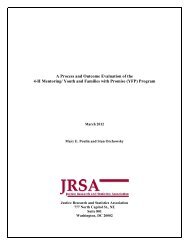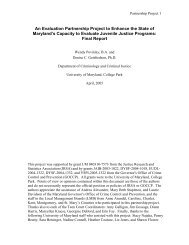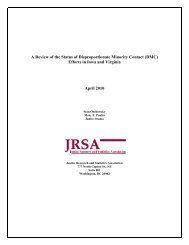Juvenile Justice System and Risk Factor Data - Illinois Criminal ...
Juvenile Justice System and Risk Factor Data - Illinois Criminal ...
Juvenile Justice System and Risk Factor Data - Illinois Criminal ...
Create successful ePaper yourself
Turn your PDF publications into a flip-book with our unique Google optimized e-Paper software.
Education<br />
In 2000, the most recent education data available, the U.S. Census Bureau reported that 6.5<br />
million people over 25 years of age in <strong>Illinois</strong> had at least a high-school diploma. A total of 3.1<br />
million males <strong>and</strong> 3.4 million females were high school graduates or beyond. Overall, <strong>Illinois</strong><br />
had a rate of 81,391 persons with at least a high school diploma for every 100,000 people 25<br />
years of age or older. When comparing education data with estimated income data, the more high<br />
school graduates there were in a county, the higher the estimated median household income was<br />
for that county.<br />
Unemployment<br />
In fiscal year (FY) 2002, 417,700 people in the labor force were unemployed in <strong>Illinois</strong>. By<br />
FY07, that number had decreased 18 percent to 341,000. The unemployment rate in FY07 was<br />
5,097 for every 100,000 in the labor force, a 22 percent decrease from the FY02 rate. In FY07, 5<br />
percent of the labor force was unemployed.<br />
Income<br />
The estimated median household income in <strong>Illinois</strong> in 2007 was $54,141. This was a 20 percent<br />
increase from the 2002 median household income of $44,946 <strong>and</strong> a 31 percent increase from the<br />
1997 median household income of $41,179. Median incomes in <strong>Illinois</strong> increased every year<br />
from 1997 to 2007, with the exception of 2002, when the median income decreased 4 percent<br />
from the previous year.<br />
Poverty<br />
The U.S. Census Bureau uses a set monetary income threshold for families that changes<br />
according to family size to calculate the definition of poverty. This threshold does not change<br />
geographically, but is adjusted for inflation. In calendar year 2007, a family of four with two<br />
adults <strong>and</strong> two children, had a threshold of $21,027. A family of three with one adult <strong>and</strong> two<br />
children had a threshold of $16,705. 11<br />
In 2007, 524,318 youth ages 17 years old <strong>and</strong> younger were living in poverty in <strong>Illinois</strong>, a rate of<br />
16,389 for every 100,000 people under the age of 18. This was a 6 percent increase from 2002,<br />
but a 9 percent decrease from 1997. Poverty rates steadily declined from 1997 to 2000. Although<br />
poverty rates began increasing in 2002, they still remained lower than in 1997. Figure 3 shows<br />
the poverty rates from 1997 to 2007 in <strong>Illinois</strong>.<br />
13

















